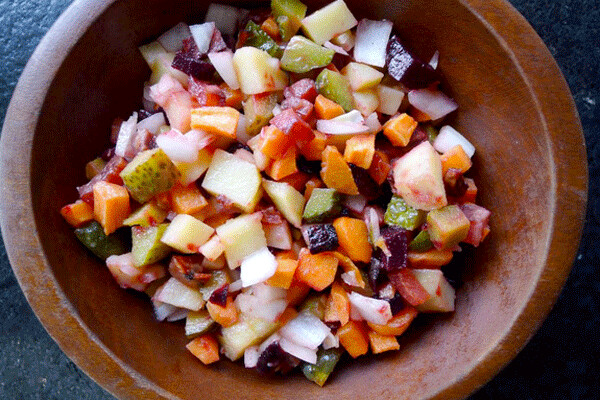How the Christmas Sweater won Thanksgiving

Winter came early this year, but the Belarusian cucumber farmers didn't care. Their cucumber plants were long gone, their fruits having been turned into pickles, which were not for sale, but they did have beets. Very exciting beets, if one were to take their enthusiastic vibes at face value.
I like beets, but not in an every-single-day way. My Belarusian friends, clearly, were deep in the lifestyle, and I wondered how they sustained that kind of pace all season long. I speculated that they must have tricks beyond pickled, boiled and borschted, and the answer turned out to be a little of all three.
When I asked the bearded, rosy-faced gentleman about his favorite beet dishes, his grin widened.
Then he leaned in, using his fingers to enumerate the ingredients: "Beets, carrots, potatoes - cooked. Chopped onions and pickles. Little bit of oil."
"Cut small," added his wife, bundled in a long blue wool coat and red scarf to match her husband's cheeks.
"3/8-inch," he said, holding two callused worker fingers in the universal symbol for small.
They call it beet vinaigrette, she says. If it had a different name back in Olshany, the village where she learned the dish from her grandmother, she didn't know it.
The acid side of the vinaigrette comes from the pickles, which are serious business back home. Olshany is known across Belarus as the nation's cucumber capital. In large greenhouses, each heated with multiple wood stoves, they start their cucumber plants as early as possible in spring, and harvest them as late as possible into the fall. The rest of the time, it's pickles and beets.
But if you're looking for the kind of beet vinaigrette that comes with with chevre cheese and balsamic, Belarus is not your place. To avoid confusion, I call it the Christmas Sweater.
At home, the Christmas Sweater was a hit with the family. The interaction of pickles and onions and potatoes was mildly spectacular, invoking the flavor of fries with a mouthful of relish, as from a bite of burger or hot dog. We couldn't stop eating it. But the Belarusians were less impressed.
At market next week, wife wasn't there. I handed husband my Christmas Sweater. He looked at me skeptically. "It's too big."
That was when I remembered his 3/8-inch directive. My chunks was more like 5/8. I felt ashamed to think that he thought my uncalloused writer fingers didn't know what 3/8 was.
He took a bite. "The taste is good," he acknowledged.
"I didn't overcook the beets?" I quizzed. He shook his head.
He agreed to bring some to his wife, and gave me his phone number.
That afternoon I called. "The flavor is good," she confirmed. "But it has to be, how do you say, more cute."
"It's too ugly?" I asked.
"Yes," she said, laughing awkwardly.
For Thanksgiving, I made sure to cut and cube as cute as could be. I would not bring an ugly Christmas Sweater to the party.
At the long table, I wondered if anyone had tried my little side dish. Then, almost on cue, the person to my left started mumbling favorably about "this relish stuff." I was thankful for Christmas sweater.
Christmas Sweater
It's bright, cute, and will keep you warm all winter.
Serves 4 as a side, 2 as a main
2 half-pound tomatoes, peeled, each cut in half
1 pound beets, peeled and cubed (see below)
½-pound carrots, peeled and cubed
1 medium onion, cubed
2 cups cubed dill pickles
½ cup olive oil
Salt and pepper, to taste
Steam the potatoes until soft on the outside and still a bit stiff in the middle, about 20 minutes.Remove from heat and allow to cool.
While that is going, peel the carrots and beets, and cube them as cutely as possible. It's best to do the beets last, or they will stain the veggies that follow.
Each vegetable will require a slightly different cubing tactic, but there are certain universals. Start by cutting each root in half, lengthwise, and lay the flat sides down. Slicing straight down, make a series of parallel cuts, ⅜-inch apart - that's half a penny - across each half.
Split your newly-sliced half like a deck of cards. As you pull apart the sliced half-root, it exposes two new flat surfaces - one on each quarter. Holding the slices of each split half together, roll the quarter onto its new flat spot. Spin them around so the flat spots that were facing down now press together.
From here, cut a grid, like the lines on a ⅜-inch piece of graph paper. Slicing straight down, make a series of parallel cuts, ⅜-inch apart. Then turn the knife 90 degrees and make another series of parallel cuts, ⅜-inch apart.
(If your eyes are glazed over after that cubing technique, just cut them into small cute cubes however you can.)
Put the cubed beets and carrots in separate baking dishes and bake at 350 for about a half-hour, stirring each pan once (with seperate implements), until they are a little soft and a little crunchy. If they start to shrink that's a bit too far. Allow the beets and carrots to cool to room temperature. After that the bleeding will be mostly staunched.
While the beets and carrots cook, make sure the cutting board is clean from the beets, and cube the potatoes, onions and pickles.
When everything is cool, cubed and cute, add the salt and oil and briefly toss.
